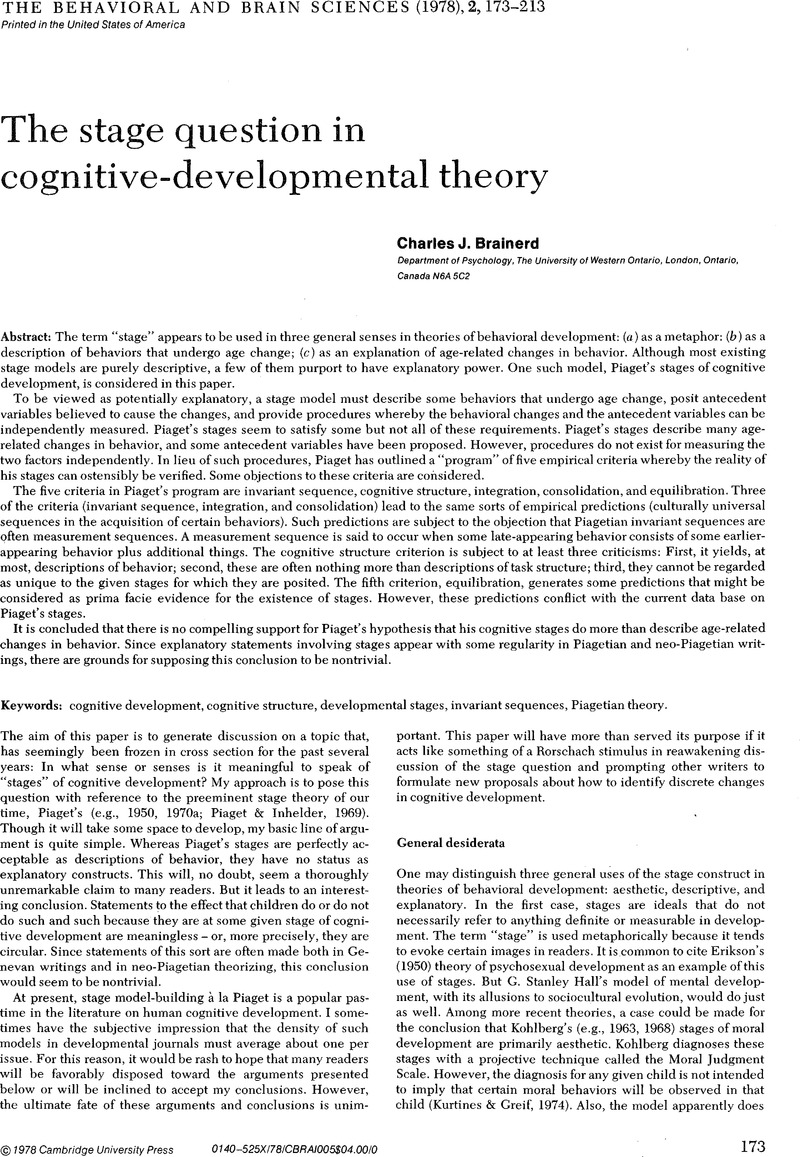Crossref Citations
This article has been cited by the following publications. This list is generated based on data provided by Crossref.
Blank, Marion
Rose, Susan A.
and
Berlin, Laura J.
1981.
Intelligence and Learning.
p.
231.
Valsiner, Jaan
and
Benigni, Laura
1986.
Naturalistic research and ecological thinking in the study of child development.
Developmental Review,
Vol. 6,
Issue. 3,
p.
203.
Johnston, Timothy D.
1989.
Piagetian stages and the anagenetic study of cognitive evolution.
Behavioral and Brain Sciences,
Vol. 12,
Issue. 3,
p.
600.
Falk, Dean
1989.
Primate tool use: But what about their brains?.
Behavioral and Brain Sciences,
Vol. 12,
Issue. 3,
p.
595.
Chevalier-Skolnikoff, Suzanne
1989.
Spontaneous tool use and sensorimotor intelligence inCebuscompared with other monkeys and apes.
Behavioral and Brain Sciences,
Vol. 12,
Issue. 3,
p.
561.
Macphail, Euan M.
1989.
Tool use implies sensorimotor skill: But differences in skills do not imply differences in intelligence.
Behavioral and Brain Sciences,
Vol. 12,
Issue. 3,
p.
602.
Chevalier-Skolnikoff, Suzanne
1989.
Tool use in Cebus: Its relation to object manipulation, the brain, and ecological adaptations.
Behavioral and Brain Sciences,
Vol. 12,
Issue. 3,
p.
610.
Pepperberg, Irene M.
1989.
Tool use in birds: An avian monkey wrench?.
Behavioral and Brain Sciences,
Vol. 12,
Issue. 3,
p.
604.
Visalberghi, Elisabetta
1989.
Primate tool use: Parsimonious explanations make better science.
Behavioral and Brain Sciences,
Vol. 12,
Issue. 3,
p.
608.
Savage, Anne
and
Snowdon, Charles T.
1989.
Apples and oranges: The pitfalls of comparative intelligence.
Behavioral and Brain Sciences,
Vol. 12,
Issue. 3,
p.
605.
Fragaszy, Dorothy M.
1989.
Tool use, imitation, and insight: Apples, oranges, and conceptual pea soup.
Behavioral and Brain Sciences,
Vol. 12,
Issue. 3,
p.
596.
Bernstein, Irwin S.
1989.
Cognitive explanations: Plausibility is not enough.
Behavioral and Brain Sciences,
Vol. 12,
Issue. 3,
p.
593.
Savage-Rumbaugh, Sue
Brakke, Karen
and
Wilkinson, Krista
1989.
Tool use in monkeys.
Behavioral and Brain Sciences,
Vol. 12,
Issue. 3,
p.
606.
Gibson, Kathleen R.
1989.
Tool use in cebus monkeys: Moving from orthodox to neo-Piagetian analyses.
Behavioral and Brain Sciences,
Vol. 12,
Issue. 3,
p.
598.
Bekoff, Marc
1989.
Tools, terms, and telencephalons: Neural correlates of “complex’ and “intelligent” behavior.
Behavioral and Brain Sciences,
Vol. 12,
Issue. 3,
p.
591.
Kortlandt, Adriaan
1989.
The applicability of Piagetian concepts to animals.
Behavioral and Brain Sciences,
Vol. 12,
Issue. 3,
p.
601.
Baldwin, John D.
1989.
Does “spontaneous” behavior require “cognitive special creation”?.
Behavioral and Brain Sciences,
Vol. 12,
Issue. 3,
p.
589.
Adams-Curtis, Leah E.
1989.
Does a Piagetian description work?.
Behavioral and Brain Sciences,
Vol. 12,
Issue. 3,
p.
588.
Tomasello, Michael
1989.
Cognition as cause.
Behavioral and Brain Sciences,
Vol. 12,
Issue. 3,
p.
607.
Parker, Sue Taylor
1989.
Imitation and derivative reactions.
Behavioral and Brain Sciences,
Vol. 12,
Issue. 3,
p.
604.





